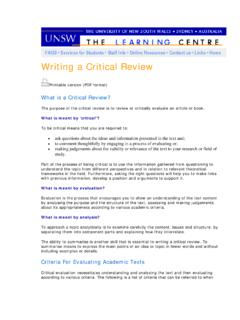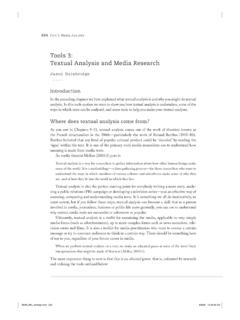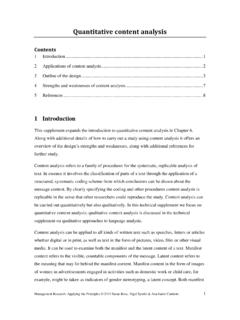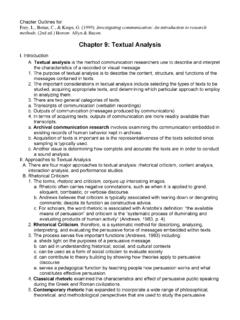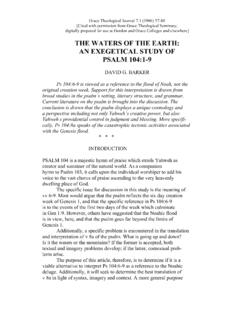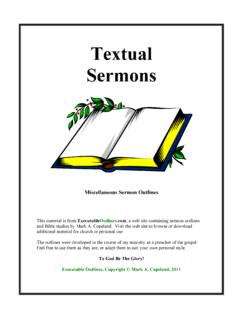Transcription of Chapter 9: Blending and NLP - UCSD Cognitive Science
1 Chapter 9: Blending and IntroductionIn this Chapter , I will discuss research in computational Natural Language Processing(NLP), in light of the linguistic Blending analysis in the previous chapters. The discussionand examples will focus on the problem of Machine Translation (MT) - the computationaltranslation of text from one natural language to another. The aim of this Chapter is not topropose computational models for natural language processing and translation. Rather, theaim is to analyze the theoretical implications of the Blending analysis (in chapters 2-7) forfuture directions of research in Kay et al. (1994) note in the introduction to their book on the Verbmobil speechmachine-translation project, to many laymen, it is incomprehensible that we can buildmachinery that can convey a man to the moon, but none that can translate even very simpletexts into French ( ).
2 After many years of painful efforts in NLP, researchers still find ithard to identify what it is exactly about language and translation that defies all attempts ofcomputational modeling, and just what could improve the quality of the result. In thischapter, I point to the role of linguistic Blending operations as one source of difficulty forcomputational modeling of language processing and as an important direction for the most problematic aspect of computational language modeling is the influenceof context on language interpretation. Numerous researchers in NLP ( , Kay et al.,1994; Nirenburg et al., 1992; Melby, 1995) have discussed the role of context as addingshades of meaning to linguistic forms, and influencing their translation. Input texts, it issuggested, cannot be processed in isolation: rather information from the contextual settingof the text must be taken into account.
3 The term context includes both linguistic context( , the previous stretch of text or discourse and, how it influences the interpretation ofthe current utterance), general world ( common sense ) knowledge, and the cultural andcommunicative setting (see section ). Kay et al. (1994) maintain that language isalways situated in some contextual setting, and that the importance of the contextual settingis erroneously overlooked since speakers take it for granted. Discussing the role of thecontextual setting in translation, Kay et al. note: every professional translator is keenlyaware that a great deal more than linguistic knowledge is required for the job .. Thatcrucial knowledge that a translator must have has almost always been overlooked ..because it is shared by most humans, especially when they have a largely common culture (p. 6). In recent years various attempts have been made to incorporate contextualknowledge into NLP systems.
4 First, knowledge-based methods developed in AI (ArtificialIntelligence) were adopted in NLP systems in the form of extra-linguistic world-knowledgedata-bases that guide the linguistic processing of input texts (see section ). Second,methods for computing textual context are also being developed1 .In this section, I will suggest that an additional crucial skill a translator (or any languagespeaker) possesses has been overlooked in research on computational modeling oflanguage: the ability to creatively generate and interpret linguistic blends of the sortdiscussed in this dissertation (chapters 2-7). While contextual knowledge has played acentral role in the examples studied in previous chapters (for example, in the imposition ofprototypical cultural-experiential scenarios on interpretation of blends), the discussion inthis Chapter will concentrate not so much on the role of contextual knowledge in language 1 While the various knowledge representation systems in AI have traditionally stressed representation ofisolated propositional meaning, we do find recent attempts to incorporate considerations of the larger textualcontext.
5 For example, Hovy (1988a,b) incorporates planning at the level of multisentential text in languagegeneration. Nirenburg et al. (1992) report that in the computation of meaning of input texts, informationabout the setting of the communication situation is incorporated including parameters such as theproperties of the participants and their relative social status (p. 75).processing as much as on the necessary mechanisms for manipulating world knowledgeand linking it to linguistic structures. For the discussion in this Chapter , I will assume that general world knowledge" ( , knowledge on prototypical scenarios in the world, or thefunctions of objects in the culture, etc.) is already coded in some form into thecomputational system. The issue I will focus on is how this knowledge is dynamicallyaccessed and manipulated for the purpose of language processing. I will claim that thedynamics of mechanisms such as Blending has been largely ignored in NLP, and thatresearch on understanding and modeling such mechanisms must be pursued in addition to,or in parallel with, research on the coding (or statistical extraction) of "common-sense"knowledge.
6 The discussion in this Chapter focuses on the complex links that exist betweengrammatical forms and semantic structures. The sentences to be discussed are isolated (de-contextualized) sentences, so the role of discourse context (and the set of pre-assumptionsit defines) will be ignored in this analysis in the previous chapters of the dissertation suggested that linguisticprocessing of even very basic clause structures (such as the English Caused-Motionconstruction, or the various Hebrew basic syntactic constructions and binyanim) involvescomplex mapping and integration operations. The language by itself provides only partialcues for the "de-integration" process: the "un-packing" and elaboration of linguisticutterances into conceptual representations. The analysis also suggests that much of the"integration" and "de-integration" operations are automatic, especially when triggered byvery entrenched, conventional linguistic blends.
7 What the entrenchment does is make theblending configuration less noticeable, but the Blending schemas themselves (extracted andgeneralized from many linguistic instances) are still available for conscious processing. Theconscious processing of Blending operations is particularly noticeable in novel grammaticalblends ( , in the coinage of novel root-binyan combinations in Hebrew - section , orin novel lexical-syntactic combinations expressing caused-motion events in English -section ), or during translation when switching between different Blending conventionsin different languages requires their conscious processing ( Chapter 8). But activation ofblends also takes place in the everyday automatic elaboration of sentences during theirinterpretation (for example, the Hebrew stem hif'il marks that the event denoted by the rootis part of a larger causal sequence. The binyan thus prompts the hearer to elaborate thesemantic content of the linguistic structure, Chapter 4).
8 In this Chapter , I will discuss therole of such "conscious" reconstruction of Blending configurations in NLP the analysis in this Chapter , I will make the following claims:(1) Though many NLP systems incorporate vast amount of general world knowledge(in the form of hand-coded or statistically extracted rules), the use of these databases ingenerating a functionally sufficient semantic representation of linguistic structures is stillvery limited. In actual practice, contextual knowledge is used primarily to disambiguate theinput text, but rarely to add information not explicitly provided in the text (informationwhich may be necessary for further processing, translation).(2) A mistake is often made when dealing with failures of an NLP system ( ,failures in providing a correct semantic model or translation, for an input sentence) inassuming that the linguistic and world knowledge structures encoded in the system arenecessarily inaccurate and should be modified or extended.
9 Often the knowledge structuresare accurate and complete, and the failure of the system results from the speaker s creativeintegration ( Blending ) of permanent knowledge structures into new temporary novelty of the input text is in the way the default structures are linguistically integratedtogether (and hence related to each other semantically in the sentence), and the goal of thesystem is to reconstruct these novel temporary blends for successful processing of thesentence. Modifying the permanent knowledge-bases of the system will not provide ageneral solution in such cases.(3) Applying contextual world knowledge solely via "pragmatics" modules whichmodify an interpretation of a sentence after a basic semantic structure is computed is oftenineffective. In the examples discussed in this dissertation, world knowledge guides thevery basic assignment of a minimal semantic structure to a linguistic utterance.
10 (4) Pre-encoded inference rules can capture only the most entrenched (repeated)instances of Blending . They cannot solve the core problem of Blending . Reconstruction ofblends has to be performed on-line, simulating human Cognitive creativity in findinganalogies and performing analogical mapping between retrieved knowledge structures andlinguistic forms. To interpret a sentence in the view of this dissertation is to reconstruct aset of correspondences--a mapping--between a linguistic form and conceptual (knowledge) should be noted here that though the discussion in this Chapter suggests that currentunderlying assumptions of NLP research cannot generally support the findings ofgrammatical Blending and translation in this dissertation, the discussion does not intend toimply that NLP research in its current form is ineffective. Not at all, because, in spite of theimmense creative nature of thought and language (as reflected in the Blending examplesdiscussed in this dissertation), much of language use is in fact entrenched and predictable(if not in a deterministic way, then at least statistically).


